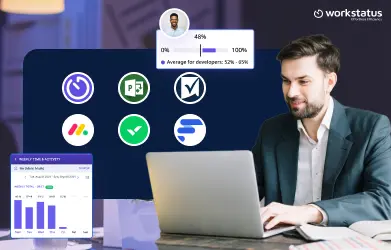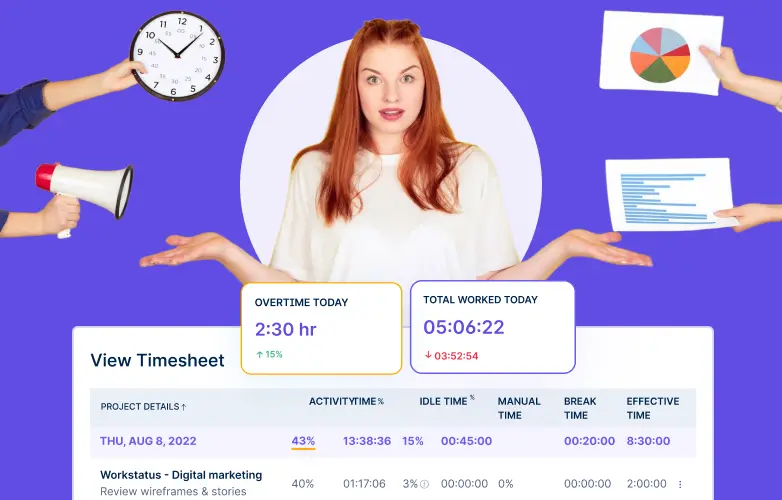Table of Contents
Introduction
Traditional management strategies are ineffective in today’s rapidly changing corporate world. Workforce analytics drives change by transforming conflicting data into insights that facilitate better decision-making and organizational adjustment.
Through workforce analytics, businesses can ensure employees are busy and engaged in productivity while planning to grow.
As organizations continue to adapt to the new normal of flexible work environments, workforce analytics becomes an imperative tool to sustain organizational competitiveness and achieve new levels of success.
Let’s get into it!
Understanding The Need And Benefits Of Workforce Analytics
The Growing Need for Workforce Analytics
Complex Workforce Management: Modern workforce management has grown bizarre because of the complexity of the jobs, variations in employees’ expectations, difficulty in scheduling, and performance evaluations. Handling it is complicated and requires proper management tools and strategies.
Remote and Hybrid Work Shift: Flexible and hybrid work arrangements have become widespread and disrupted conventional workplaces. Managers must incorporate management approaches and utilize IT solutions to manage and motivate employees in different places.
Growing Competition and Efficiency Needs: With increased competition in various industries, firms need to work at the most optimal level possible. Using workforce analytics facilitates efficiency in organizational processes, proper staffing, and sustainable business competition.
Key Benefits Of Workforce Analytics
Here are some prime benefits of workforce analytics:
Improved Employee Productivity and Performance: Analyze performance patterns and efficiency to improve individual and collective effectiveness, similar to how Google ads analytics provides insights for optimizing ad campaigns.
Enhanced Talent Acquisition and Retention: Use such information to revise and enhance the recruitment process and methods to obtain highly qualified personnel and retain them by meeting their needs and organizational objectives.
Did You Know?
Organizations that use workforce analytics record 21% more productivity and higher business success.
Optimized Workforce Planning and Scheduling: Analyze workforce data to identify employee staffing requirements and optimize staffing and resource distribution to meet business needs.
Reduced Operational Costs: Pinpointing cost overruns and opportunities for optimization and enhancing assets’ operating costs.
Better Employee Engagement and Satisfaction: Invest in technology that collects information about employees to make the workplace more stimulating and increase satisfaction with the job.
Types of Workforce Analytics
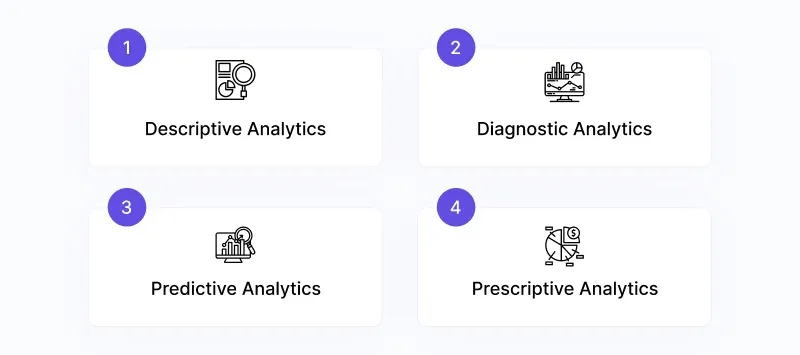
Here are prominent types of workforce analytics:
1. Descriptive Analytics
Descriptive analytics mainly involves using past workforce data to determine what has happened. It provides an answer to the question, ‘What happened?’ It focuses on gathering facts, structuring, and evaluating data.
For workforce management, these may include employee turnover rates, truancy levels, average service duration, or employee profile analysis. Descriptive analytics is the first level, giving a real-time and historical view of the organization and its functioning.
2. Diagnostic Analytics
Diagnostic analytics is more comprehensive because it seeks to explain why specific occurrences or trends happened. It responds to the question, Why did it happen? This analytics further breaks down the descriptive data to determine why certain occurrences happened.
Using diagnostic analytics in workforce management might seek to explain high turnover rates, increase in productivity, or low employee satisfaction. Diagnostic analytics enable organizations to understand the forces that affect the strength of the human resource within the workforce.
3. Predictive Analytics
Predictive analytics analyzes historical data, and one tries to determine what will happen in the future based on certain patterns. It answers the question, ‘What is likely to occur?’ Predictive analytics uses machine learning and data mining algorithms to analyze the data and predict more about future workforce demands and behaviors.
For instance, applied predictive analytics can be valuable in estimating the number of skills needed in the future, identifying potential turnover, or predicting workload in light of expected organizational growth.
4. Prescriptive Analytics
Prescriptive analytics is the most proactive, as it aims to suggest the best course of action to attain specific goals or avoid problems. It can answer the question, “What should we do?” Such analytics employ optimization and simulation methods to determine how certain goals and constraints can be achieved.
Regarding WM, prescriptive analytics might signify the number of employees to hire, who should be retained or let go, and which programs should be adopted to address competence shortages.
Challenges and Considerations
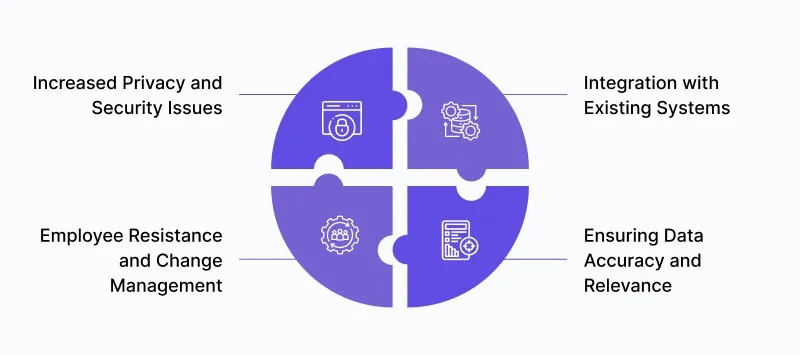
Here are common challenges and considerations related to workforce analytics:
Increased Privacy and Security Issues
One of the most critical issues in workforce analytics is ensuring the security of the employee data collected. Organizations must consider regulatory compliance and security procedures to protect data and prevent unauthorized access.
Considerations: Data protection laws and regulations such as GDPR and CCPA, data encryption, users’ authentication and access rights, and security checks.
Integration with Existing Systems
Implementing workforce analytics involves customization and connectivity with other human resource management systems, payroll solutions, and enterprise applications. These aspects indicate that integration is essential to ensure data is accumulated and analyzed reliably.
Considerations: Integration with existing applications, existing APIs, data transfer issues, and possible system customization.
Employee Resistance and Change Management
Some challenges of workforce analytics include a need for more organizational commitment and buy-in by the workforce. Some employees may resist the idea because they consider it being monitored frequently or do not believe in it. Strategic practices that facilitate change are necessary to guarantee the employee’s acceptance.
Considerations: Benefits must be communicated effectively, staff must be involved in the change process, training and assistance must be given to make the change, privacy concerns must be addressed, and corporate culture must be promoted.
Ensuring Data Accuracy and Relevance
Workforce analytics is only as good as the data to derive insights and conclusions. The credibility of the insights and the options depends greatly on the quality of the data available, which includes accuracy, completeness, and relevance.
Considerations: Selecting proper data, scanning, cleaning, normalizing data entry, establishing the concept of real-time data updates, and prohibiting isolated data.
Workstatus – The Right Workforce Analytics Solution
Workstatus offers a comprehensive workforce analytics solution that supports an organization’s decision-making process with its most important resource—its employees. It is the solution that transforms unmanageable employee data into more manageable information using such clever technologies, enabling organizations to make informed workforce management decisions.
Here is how Workstatus serves as a workforce analytics solution for your business:
Data Collection and Integration
Workstatus can easily be synchronized with other data inputs, such as time tracking, attendance, project management systems, and human resource management information systems. This integration offers a systemic view of the workforce’s activities and productivity.
Real-Time Analytics Dashboard
It helps to track and display vital information about the workforce in a simple, real-time web interface. This enables the managers to track the team’s performance, productivity trends, and even the attendance patterns that prevail in the organization.
Customizable Reporting
Workstatus has flexible reporting systems that enable users to define the type of report they need. Such reports can encompass all the aspects of WS analytics, ranging from an individual’s performance to overall team tendencies.
Performance Tracking
Workstatus includes several elements for assessing employee performance and provides an opportunity to analyze the results to determine the best performer and who might need more assistance.
Attendance and Time Analytics
Workstatus offers detailed insight into an organization’s general attendance and time spent, allowing for enhanced scheduling and workforce productivity.
Steps To Implement Workforce Analytics In Your Business
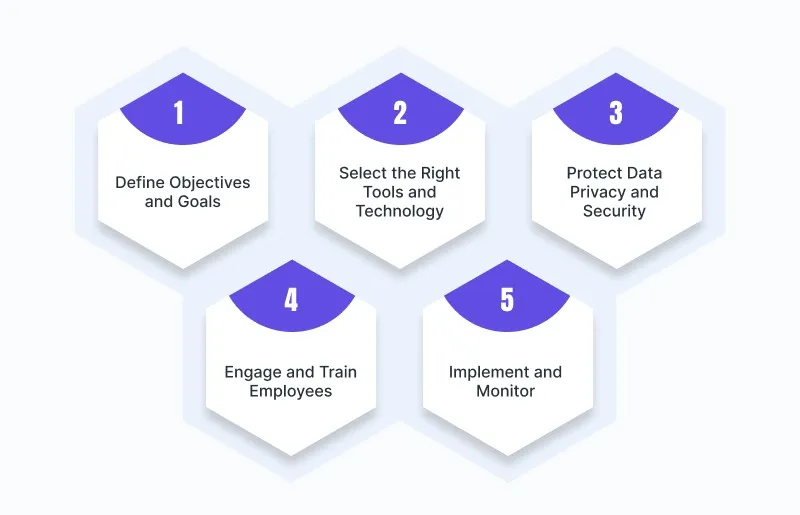
Here are some steps to implement workforce analytics in your business:
a. Define Objectives and Goals
When setting goals for your workforce analytics initiative, be clear about what you want to achieve. Set measurable targets, such as increasing employee performance, decreasing attrition rates, refining methods of personnel acquisition, or increasing engagement.
Action Steps: Attend stakeholder meetings, review KPIs, and map analytics goals with the organization’s objectives.
b. Select the Right Tools and Technology
Choose the right workforce analytics platform to serve your organization. Important criteria include integration, usability, flexibility, and specific settings and options provided.
Action Steps: Gather and evaluate available solutions, look for demo and trial options, and talk to the IT and HR departments.
c. Protect Data Privacy and Security
Ensure data privacy measures to prevent the leakage of employees’ information and adhere to data privacy laws. This is important in developing trust and preventing legal matters from arising.
Action Steps: Create a data protection plan, incorporate the necessary security measures, and educate personnel on data security measures.
d. Engage and Train Employees
Brief your team on workforce analytics. This involves addressing any issues, outlining the advantages of the new tools, and giving everyone sufficient practice using them.
Action Steps: Organize workshops and seminars, write manuals and guidelines, and regularly consult users.
e. Implement and Monitor
Conduct a top-down implementation of the workforce analytics software. Measure how it works and adjust regularly to help it meet your goals and objectives.
Action Steps: Fully adopt the solution in the organization, set up an evaluation system, and perform periodic evaluations to identify gaps and trends.
Examples of Workforce Analytics in Action
Workforce analytics may sound important, but it can still be difficult to comprehend how it works. Let’s examine a few examples of when it can directly affect profits:
Example 1: Reducing Overtime Hours
For instance, you may have observed employees working extra hours and want to know whether this results from managerial actions, a lack of adequate workforce, or other causes. Workforce analytics can assist you in determining the root of the issue and how to fix it.
Besides, you could change your leave of absence policy to effectively address cases of absence in your workforce without necessarily having to compensate your employees for overtime.
Example 2: Talent Acquisition and Employee Retention
Surveys and exit interviews can help determine why people are leaving your organization, but they only sometimes provide the complete picture. Generally, workforce analytics can offer insights into internal data and other industry information, including salaries, employee satisfaction levels, diversity, workforce composition, etc.
Learn whether employers are turning down your job offers for internal or external reasons and what measures can be taken to enhance the recruitment and selection process.
Example 3: Succession Planning
Although it is frequently expected that some employees may leave their positions, these resignations are usually unexpected. Use statistical analysis to identify which seniors and potential successors may leave the company soon.
Example 4: Performance Management
With access to workforce analysis, performance management becomes more than just a disciplinary tool. It can be used to mentor exceptional workers for various future roles and provide them with essential skills for the long term.
Closing Thoughts
Therefore, workforce analytics is crucial for organizations seeking to improve efficiency and effectiveness through strategic resource management. Performance analytics gives companies an edge, helps retain employees, and helps them retain better performance. Adopting workforce analytics increases employee commitment and productivity and provides a strong framework for building long-term business success.



